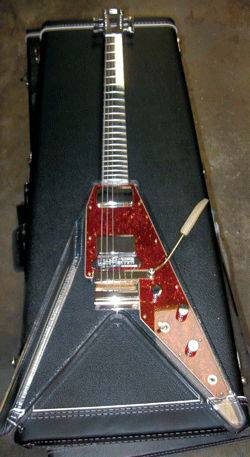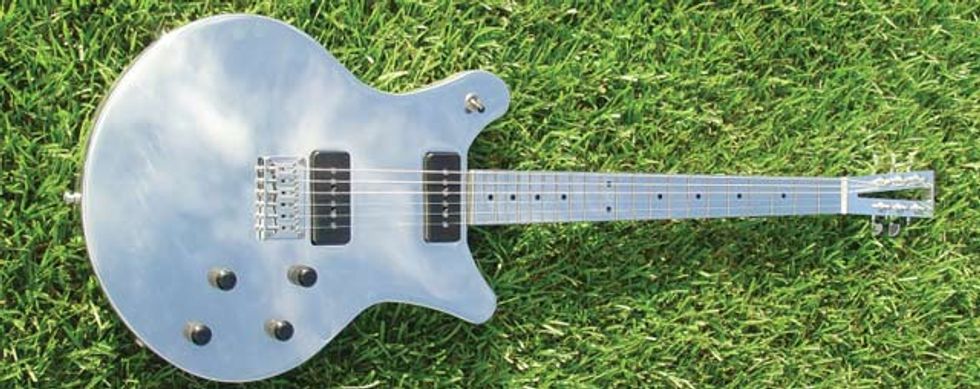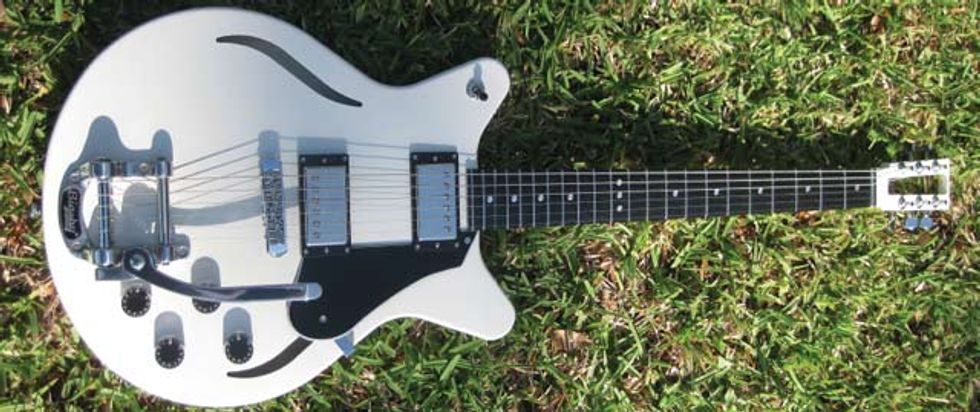
Electrical Guitar Company draws inspiration from Travis Bean, et al, by using aluminum in the construction of their instruments
Until about nine years ago, Kevin Burkett was like many of us: a player, a modifier, a guy with a day job fixing ATM machines and doing other mechanical repairs. He had a serious fixation with guitars, but could never imagine building them. “I’ve always enjoyed tinkering and repairing them, but building one from scratch always seemed like a huge undertaking,” says Burkett. “But I needed a guitar for a band, so I developed the initial prototype.” And Electrical Guitar Company was born.
A adherent of the building philosophy of luthiers Travis Bean, Marc McElwee and John Veleno, his custom guitars sometimes have similar quirks—split headstock and machined aluminum necks with wooden bodies. “I cut my teeth on building years ago by repairing and restoring Travis Bean guitars,” he says. “I really like bringing them back from the dead. They are just super cool guitars.” Unlike his predecessors, however, Burkett takes the metallic-element guitar to another level. He builds guitars with aluminum bodies (Hulett T6061) and necks (Alcoa T6061) with stainless steel frets that come loaded with EGC custom pickups.
The tonal reason for working with aluminum is simple. “I was always told ‘denser the wood, better the sound,’ so why not use metal?” he says. “It adds a crisp brilliance that you just can’t get with wood. It almost has a piano like chime to it… once I heard it, I was sold.” In addition, Burkett prefers the aluminum necks because there’s no truss rod to adjust and you never have to worry about the neck warping. He now builds with another dense material: Lucite. But Burkett has to compensate for its lack of resonance. “I isolate the metal neck internally via aluminum plates, allowing the neck to ring out without being dampened by the plastic,” he explains. “It works very well, and gives the guitars a life that generally can’t be had with plastic.” The Lucite V model was a collaboration with Brent Hinds of Mastodon, one of Burkett’s favorite players. It has a tortoiseshell pickguard, Gibson Flying V Maestro vibrato and aluminum neck and headstock.
Eight years after his initial, hesitant undertaking to build a guitar from scratch, Burkett has only turned away one proposal. “I’ve taken on some pretty difficult ideas, like 12-string basses, an 8-string baritone with the two highest strings being doubled and the two octave strings going to a tremolo, and an aluminum violin,” says Burkett. “So far I’ve never turned down a custom job, with the exception of making a dead-on copy of something else… that’s something I just won’t do.” And by the looks of his original guitars, why should he?
electricalguitarcompany.com


A adherent of the building philosophy of luthiers Travis Bean, Marc McElwee and John Veleno, his custom guitars sometimes have similar quirks—split headstock and machined aluminum necks with wooden bodies. “I cut my teeth on building years ago by repairing and restoring Travis Bean guitars,” he says. “I really like bringing them back from the dead. They are just super cool guitars.” Unlike his predecessors, however, Burkett takes the metallic-element guitar to another level. He builds guitars with aluminum bodies (Hulett T6061) and necks (Alcoa T6061) with stainless steel frets that come loaded with EGC custom pickups.
The tonal reason for working with aluminum is simple. “I was always told ‘denser the wood, better the sound,’ so why not use metal?” he says. “It adds a crisp brilliance that you just can’t get with wood. It almost has a piano like chime to it… once I heard it, I was sold.” In addition, Burkett prefers the aluminum necks because there’s no truss rod to adjust and you never have to worry about the neck warping. He now builds with another dense material: Lucite. But Burkett has to compensate for its lack of resonance. “I isolate the metal neck internally via aluminum plates, allowing the neck to ring out without being dampened by the plastic,” he explains. “It works very well, and gives the guitars a life that generally can’t be had with plastic.” The Lucite V model was a collaboration with Brent Hinds of Mastodon, one of Burkett’s favorite players. It has a tortoiseshell pickguard, Gibson Flying V Maestro vibrato and aluminum neck and headstock.
Eight years after his initial, hesitant undertaking to build a guitar from scratch, Burkett has only turned away one proposal. “I’ve taken on some pretty difficult ideas, like 12-string basses, an 8-string baritone with the two highest strings being doubled and the two octave strings going to a tremolo, and an aluminum violin,” says Burkett. “So far I’ve never turned down a custom job, with the exception of making a dead-on copy of something else… that’s something I just won’t do.” And by the looks of his original guitars, why should he?
electricalguitarcompany.com


whats-newhumbucker-equippedlp-styleus-mademarch-2010boutiqueplayer-modifier-kevin-burkett-build-imagine-repair-buy-scratch-sell-undertake-huge-custom-alumnium-necks-wooden-bodiesgear-galleriescustomp-90-equippedmodern-builder-vaultguitarselectrical-guitar-companybaritoneeye-candysolidbodysemi-hollowbodygear

